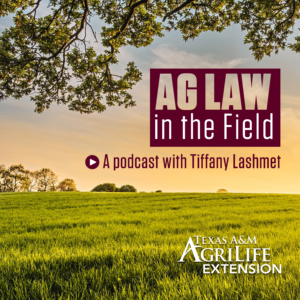*If you missed our 2018 Year in Review post focusing on the national level, click here.*

As compared to the national year in review, things were a bit quieter this year here in Texas. That said, there were a few important cases decided in 2018 that I want to highlight and bring to your attention.

Court addresses applicable standard when bull is hit on the highway.
In Garcia v. Pruski, an important case out of Wilson County, the San Antonio Court of Appeals addressed legal issues related to a bull getting hit on the highway. [Read prior blog post here.] Two key concepts were included in the Court of Appeals opinion.
First, in a situation where an animal is hit on a highway in a county with a local stock law, which standard applies? For state highways, the applicable legal standard is that a landowner can be liable if he “knowingly permits” the animal to run at large, but for counties with local stock laws, the legal standard is that a landowner can be liable if he “permits” the animal to run at large. The San Antonio Court of Appeals held that the more plaintiff-friendly “permit” standard applied. In this case, although the court ruled that the plaintiff did not offer sufficient evidence to satisfy the more stringent “knowingly permit standard,” the judge found there was sufficient evidence to allow the case to go to a jury on the issue of “permit.”
Second, in looking at how to analyze the definition of “permit” under a local stock law. What is “permitting” an animal to run at large? While prior cases had taken a fairly strict viewpoint, stating that in order to prove someone permitted an animal to run at large, a plaintiff would have to show “knowing conduct” or “gave consent expressly or formally,” the court in this case appeared to adopt a much more relaxed standard, which favors a plaintiff. Here, the court said that permit may be proven “by evidence showing the person was at fault in allowing any mentioned animal to run at large.” Utilizing this standard, the court held that the facts in this case–that the bull owner latched, but did not lock his gate, the owner knew there was a risk the bull could get out without a lock, and that the bull owner did not have a cattle guard–was sufficient to allow the question to go to a jury.
The bull owner in this case has sought review from the Texas Supreme Court. This is an important ruling for Texas land and livestock owners, as it appears to modify the standard at play in cases where animals are high on the highway in favor of the injured plaintiff. A group of agricultural and landowner groups including Texas Farm Bureau, Texas & Southwestern Catlte Raisers Association, and South Texans for Property Rights has filed an amicus brief in this case, highlighting many of these concerns and urging the Texas Supreme Court to grant the petition for review. [Read amicus brief here.] In November, the Supreme Court requested a response from the plaintiff to the Petition for Review. The deadline for that response to be filed is January 16, 2019. {UPDATE: In June 2019, the Texas Supreme Court granted the Petition for Review.}
For more information on fence law, check out our handbook, “Five Strands: A Landowner’s Guide to Fence Law in Texas.”
Landowners without producing wells not entitled to party status in GCD permit protest lack standing to appeal permit decision.
What would a Texas Year in Review post be without at least one water law dispute? Litigation out of Bastrop County in End Op, L.P. v. Meyer, raised an interesting question. Do landowners without producing wells have the right to protest a nearby well in a Groundwater Conservation District (GCD) permitting process? As you will see below, the answer to that remains somewhat unsettled, but in a state that recognizes private property ownership in groundwater, this issue is almost guaranteed to continue coming up.
In this case, End Up (now owned by Recharge) applied for a permit in 2013 from the Lost Pines GCD to withdraw 56,000 acre-feet of water per year from the Simsboro formation of the Carrizo-Wilcox Aquifer in Bastrop and Lee Counties. The company planned to export that water and sell it to Hays, Travis and Williamson Counties. In response, five parties sought to oppose the permit. One party had competing wells currently producing in same aquifer. The other four parties all owned land in the area, but did not have competing wells at that time. An Administrative Law Judge held that the landowners without competing wells were not allowed to challenge the permit due to the lack of competing wells. The GCD granted a permit to Recharge.
The landowners who were denied the opportunity to participate in the protest filed suit in Bastrop County. The trial court judge sided with the landowners, finding that the GCD improperly excluded them from party status during the permitting process. As a result, the Lost Pines GCD’s decision to grant Recharge’s water permit was overturned because the landowners should have been able to participate as parties at the contested case hearing over the permit.
Recharge appealed the decision. In August, the Austin Court of Appeals dismissed the case. [Read Opinion here.] While the court did not address the merits–meaning they did not answer the question of whether a landowner without a producing well is permitted to participate in a contested case hearing–they did determine that the trial court lacked subject matter jurisdiction to hear the case. Because judicial review of a GCD permit hearing outcome is allowed only for the district, the applicant, and the parties to a contested case hearing, and the plaintiffs here were none of these, the court simply did not have the power to rule in this case.
The landowners filed a motion for rehearing, which was denied in December. It remains to be seen whether they will seek review from the Texas Supreme Court.
So where does this leave landowners with no competing wells when a GCD permit hearing occurs? The law is not clear. Would other administrative law judges reach a different result and allow them to participate as parties because of their property interest in the groundwater at stake? Or, would another administrative law judge reach the same result and find that the landowners could not be a party to the case? If so, rather than appeal the decision rendered on the permit, the landowners might pursue other causes of action, such as filing a constitutional takings claim, for which they would likely have the standing held to be lacking by the Austin Court of Appeals. It is not clear how this will play out, but it is an issue that is likely not going away anytime soon.
For more information on Texas water law, download our “Basics of Texas Water Law fact sheet” and check out our podcast episodes on groundwater (featuring Doug Caroom) and on surface water (featuring Carlos Rubenstein).
Case limits width of old, blanket easement.
A decision from the Texarkana Court of Appeals in Southwestern Electric Power Company v. Lynch, may offer some hope to landowners dealing with old, blankets easement on their property. While this case is certainly limited in scope, it could prove useful in certain similar factual situations.
In this case, Bowie County landowners’ property was burdened by a 1949 utility easement. None of the easement documents specified the width of the easement. Since 1949, the company has continually used the easement to construct, service, and maintain electric transmission lines, historically using approximately 30 feet in total width. In 2014, the company began to rebuild and modernize the lines and offered landowners $1000 in exchange for supplementing the existing easement with an express width of 100 feet.
The plaintiffs in this case refused the $1,000 offer and contended the company’s use should be limited to the historically used 30′. The trial court judge sided with the landowners and limited the easement to 30′ wide. The company appealed.
The Texarkana Court of Appeals reversed and sided with the landowners. [Read prior blog post here.] The court reasoned that where an easement is silent as to width, as this one was, the company was “entitled to use as much of the landowner’s property as is reasonably necessary, while being as little burden as possible.” The court rejected arguments from the company relying on other prior decisions in cases where easements expressly allowed additional lines to be laid and cases where the easement expressly agreed to allow for relocation, deciding that here, under a general easement, once the location was selected, “its rights then become fixed and certain.”
Not surprisingly, the company has sought review of this decision by the Texas Supreme Court. A number of groups on both sides have filed amicus briefs in this case. [Click here for list and PDF downloads.] Several agricultural groups have done so, urging the Supreme Court to deny review as there was no error by the lower level courts in this case. In December, the Texas Supreme Court requested briefs on the merits from the parties.
This case certainly highlights a major issue for Texas landowners. Many of us own property upon which there are old, blanket easement agreements in place. It is not uncommon for a landowner to seek some sort of limitation on what may be done pursuant to those agreements. While this case certainly is factually specific, it at least offers an argument that the width of old, blanket easements should be limited in the right facts exist.
Court addresses requirements to claim title to property by adverse possession with use of grazing.
Adverse possession may be one of the most misunderstood legal concepts, so it is not one of my favorite on which to write or speak. However, an important decision from the Waco Court of Appeals in Parker v. Weber illustrated the law related to adverse possession when issues arise due to fences not on property lines where grazing is the use to which the land is put. [Read prior blog post here.]
In this case, the parties disputed ownership of a 20 acre parcel of land. For decades, Mr. Weber used the 20 acres to graze cattle. Although the property line was along a river north of the 20 acres, the 20 acre parcel was fenced with Mr. Weber’s property and he assumed it was his. When the Parkers purchased adjacent property and began to work the 20 acres, which they owned based upon a survey due to the property line along the river, Mr. Weber filed suit claiming ownership due to adverse possession.
The doctrine of adverse possession allows a person to claim and obtain title to real property presently owned by another. It is also commonly known as “squatter’s rights.” Essentially, it allows a person who possesses and uses another’s land without permission to eventually become owner if a number of requirements are met. Keep in mind, succeeding on a claim of adverse possession is very difficult.
Here, the Waco Court of Appeals found that Mr. Weber failed to prove ownership by adverse possession. The court laid out the requirements for proving adverse possession when the use argued is grazing livestock. In order to successfully prove adverse possession in these circumstances, a party must show that the fence at issue was a “designed enclosure” rather than a “casual fence.” If the disputed land is merely fenced in with other land, the enclosure is casual. Conversely, where a party takes steps to affirmatively build a fence, or make substantial modifications to an existing fence, that is more likely to qualify as a designed enclosure, which could potentially support an adverse possession claim.
Based on this law, the court found that Mr. Weber offered no proof that the fence was a designed enclosure. He did not build the fence himself. He did not show that he took any action to substantially change or improve the fence. Thus, no designated enclosure existed and adverse possession was not satisfied.
Again, the takeaway here is that it is very difficult to obtain title to the property of another by adverse possession. This is especially true when the claim relies on fences built outside the property line and grazing livestock. In order to make a successful adverse possession claim in these circumstances, one must show evidence to convince a court the fence at issue was a designated enclosure as opposed to a casual fence. Absent that type of evidence, the would-be adverse possessor cannot succeed.
Mr. Weber filed a motion for rehearing, and the court requested a response from the Parkers. No order has yet been entered on that motion.
For those of you interested in the topic of adverse possession, I’ve got a podcast episode featuring Amber Miller all about this area of law.












